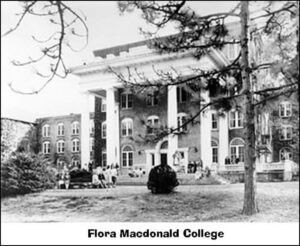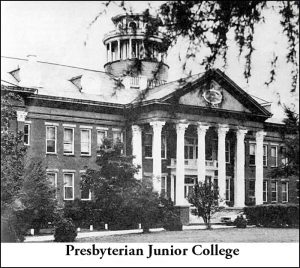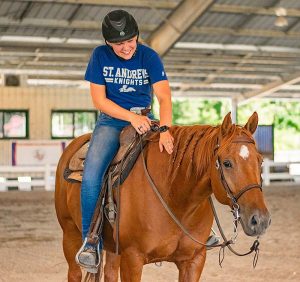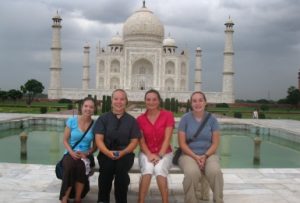On April 15, 1959, a groundbreaking ceremony, held at what is now the east end of Lake Ansley Moore, marked the beginning of the construction of the physical plant on the 800-acre site south of Laurinburg. A college administration was formed. Dr. Ansley C. Moore was named President, joining Business Manager Silas M. Vaughn who had already been employed by the College. The first Dean of the College, Dr. Price Gwynn of Flora Macdonald College, soon joined them. All these appointments were made by the Board of Trustees, chaired by Mr. Hector MacLean, a prominent banker from nearby Lumberton who provided the College with strong vigorous leadership during these crucial early years. On September 23, 1960, The Board of Directors named the new institution St. Andrews Presbyterian College.
Almost exactly one year later, on September 22, 1961, the College opened with 750 students. The first classes met at eight o’clock in the morning followed by the first Opening Convocation. Although construction continued, ten buildings had been completed in splendid modern forms accented by rows of ancient Celtic crosses. The Academic Building and the Vardell Building were located on the south campus. On the north campus were the Student Center, a maintenance building, and six residence halls named for presbyteries in the Synod of North Carolina. A large central area had been turned into a quiet lake whose nearly equal parts were separated by a long causewalk. Two men’s dormitories, DeTamble Library, and the Physical Education Center would be built before the decade closed.
The campus was designed to be largely barrier-free, permitting the College to move quickly to the forefront of service and research in the education of physically disabled students. Long before it became a legal imperative to design and convert facilities to accommodate the wheelchair, St. Andrews pioneered in serving the educational needs of students with physical disabilities.
The most distinctive and successful of all programs at St. Andrews in its first years was the Christianity and Culture Program, known as “C&C.” During the most successful years of “C&C,” students in the freshmen and sophomore courses studied ancient and modern civilization, emphasizing European trends. The junior year was given to the study of non-Western cultures. The senior year included a course in American studies and a final course in studies of the future. During each summer for many years, C&C was also taught abroad with students and a team of instructors traveling and studying in Israel, Greece and Rome.
Continuing in the tradition of a team-taught interdisciplinary core curriculum, St. Andrews introduced in 1969 a two-term course in the natural sciences. Selected Topics in Modern Science, known as STMS, was offered at the freshman level and was required of all students. STMS developed into a widely acclaimed interdisciplinary course that pioneered relating the scientific disciplines to one another. Taught by a carefully recruited team of scientists, STMS quickly became one of the finest introductory science courses in the nation. To house STMS and other interdisciplinary courses, two unique facilities were especially designed according to curriculum needs. The Morgan-Jones Science Center and Avinger Auditorium were completed in 1970.
St. Andrews could look back upon a first decade of truly remarkable achievement. In ten short years, the College had become a national leader in undergraduate liberal arts and science education. Enrollment had grown to more than 900, with a nearly equal balance between men and women. More than half of these students came from outside North Carolina, reflecting the national reputation of St. Andrews. Scholars and educators from every region of the country and even from abroad came to the campus to study the highly successful curriculum in the liberal arts and natural sciences and to view the science complex as a model undergraduate teaching facility.
The momentum of the 1960s unfortunately could not be sustained during the next decade. During the early 1970s, St. Andrews faced the same difficulties experienced by private institutions of higher education throughout the nation. Campus unrest stemming from the unpopular Vietnam war, the rising cost of education, and the traumatic economic recession, coupled with the foreign oil embargo, all contributed to serious difficulties experienced by independent colleges in the 1970s. Despite financial struggles, decreased enrollment, and reductions in faculty, the College refused to retreat from its commitment to high-quality undergraduate education. Changing student needs led to the replacement of the Christianity and Culture Program with the new St. Andrews Studies Program (SAS). This change, along with the carefully planned revisions in some major programs, enabled the College to continue to offer high-quality instruction during these difficult years when resources were extremely scarce. The College, in fact, strengthened many of its academic programs during these hard times.
In the late 1970s, the physical plant of the College underwent further changes, including making buildings more fuel-efficient. Important structures were added and overdue renovations were made. The Student Center was renovated, redecorated, and named the William Henry Belk College Center. The Katherine McKay Belk Tower was built on Chapel Island as a 16-bell carillon, dominating the center of campus. Kings Mountain dormitory was fully renovated in 1978, renamed Pate Hall, and made into a continuing education center, reflecting the College’s concern for adult education and service to the community and the churches of the Synod of North Carolina in the Presbyterian Church (U.S.A.).
In 1978, following discussions with the Department of Public Instruction officials in Raleigh, St. Andrews began its 21-year service as the campus for the Governor’s School East, a special summer program for gifted and talented high school students in North Carolina.
In 1980 and 1981, the core programs of the College were revised to incorporate into the curriculum the best elements of the former C&C, SAS, and STMS programs. The new St. Andrews General Education Program, called SAGE, restored a historical component to the general college program, in keeping with the College’s concern for international studies. The SAGE program also broke new ground in curriculum development by introducing interdisciplinary studies bridging the humanities, social sciences, and natural sciences. Academic majors were also strengthened in areas where student demand for services had increased, especially in mathematics, computer science, psychology, the natural sciences, and business administration.
The St. Andrews international programs provide many opportunities to students who choose to travel and study abroad during their four years at the College. St. Andrews hosts regular terms at the University Cuenca in Ecuador; and Brunnenburg Castle in the Italian Alps. St. Andrews was only the second college in the United States to send a group of students to Vietnam. A variety of short trips to destinations such as Cuba, Greece, Mexico, South Africa, Scotland, England, France and India have rounded out the summer offerings. The international program takes the same interdisciplinary approach, as do programs throughout the St. Andrews curriculum. Each year St. Andrews enjoys students from other countries—among them, England, Canada, Korea, Zimbabwe, and Ecuador—who live and study on the Laurinburg campus.
In 1990, St. Andrews extended its commitment to high-quality education to adult students through a satellite program at nearby Sandhills Community College in Pinehurst. The St. Andrews at Sandhills program offers junior and senior level courses in the evenings and on weekends, enabling students with job and family responsibilities to complete four-year degrees. The St. Andrews-at-Sandhills program enjoyed significant enrollment increases each year until Fall 2007 when a decline began.
In 2007, St. Andrews further extended its commitment to adult students through the online programs designed to provide degree and certificate options. Shortly following the beginning of the online programs, the educational opportunities for adult learners were consolidated into the Center for Adult and Professional Studies (CAPS) and the online and satellite programs are currently housed and administered there.
In 2009 St. Andrews formally aligned itself to aggressively recruit military personnel. St. Andrews gained membership in the Servicemembers Opportunity Colleges Consortium (SOC) and received national recognition as a military-friendly institution. Military students, or their dependents, may be traditional campus or CAPS students and access a variety of military related education benefits.
For more than 40 years, the internationally acclaimed St. Andrews Press has presented a unique window on the world for readers and writers through its publications. The St. Andrews Press began publishing in 1972. Since then it has published over 200 books (about 85 still in print), many of which have received praise from those in a position to recognize and appreciate literary quality. The special character of the Press has been its commitment to introduce new or unknown writers to a larger audience, and to showcase and enhance the stunning vitality of the “grass-roots” literary culture of America, as well as, provide tremendous experiential opportunities for students.
Since the average life span of a small press is two to three years, the Press’s more than forty years of continuous publication is a rare distinction. Samuel Tallmadge Ragan, late Poet Laureate of North Carolina said of the college and the Press: “St. Andrews has earned a splendid reputation for its liberal arts and especially its writing program, of which the St. Andrews Press is a crown jewel.” Additionally, the weekly Fortner Writers’ Forum provides a venue for writers and performers with large and appreciative audiences, and has welcomed readers such as Tom Wolfe and James Dickey.
The Scottish Heritage Center and the St. Andrews Pipe Band are logical extensions of the College’s Scottish Heritage. The Scottish Heritage Center was created in the fall of 1989 to highlight and preserve Scottish heritage as well as to honor individuals rendering outstanding service to the preservation of Scottish heritage. In 1996 the Center was moved into the DeTamble Library, and in 2009 relocated to its own building on campus, where it houses a collection of rare materials related to Scottish-American history, genealogy, traditions, and culture. It is also the home of the Fiona Ritchie Radio Archive for the well-known National Public Radio program “The Thistle and Shamrock.” The St. Andrews Pipe Band, with pipers and drummers from all over the nation, continues to be an award-winning band noted as one of the top bands in the eastern United States. In 1998 the band recorded an album of music that has been featured on National Public Radio as well as the BBC Radio in Scotland. A second CD was produced in 2002. The band took top honors in Division III competition in 2006 of the Eastern United States Pipe Band Association.
The St. Andrews Equestrian Program is a national leader in the development of educated horsewomen and horsemen. The academically oriented program offers a tremendous diversity of experience for the novice horse lover, serious competitor, or the career-oriented equestrian. St. Andrews is a national leader in combining riding with academic excellence. The Therapeutic Riding degree, begun in 1996, was the first undergraduate degree of its kind in the country.
The St. Andrews Equestrian Team continues to be national champions by winning the ANRC in 1996, 1997, 2000, 2001, 2002, and 2007. St. Andrews hosted the national ANRC championships in 2002 and 2006, as well as hosted the Intercollegiate Dressage Association in 2006. St. Andrews finished second in the 2006 ANRC championships. The Western Program boasts four IHSA Regional Championships (2006, 2007, 2008, and 2009) and four IDA National Final Qualifications (2002, 2003, 2004, and 2005).
Over the years St. Andrews has received recognitions in various national publications, in both books and periodicals, which drew attention to the quality of the college’s academic programs and the opportunities afforded to its students.
In 1989, St. Andrews was cited in the book, Colleges That Enable. This was the first in a series of recent national recognitions of the overall quality of the total St. Andrews educational experience that has continued unabated. In the following year, 1990, St. Andrews was profiled in the book, Looking Beyond the Ivy League. In 1996, the college was featured in a third book, Colleges That Change Lives. The introduction tells its student readers: “Any one of the 40 colleges profiled here will do at least as much as, and usually far more than, an Ivy League school, an Ivy clone, or a major research university to give you a rich, full life, and to make you a winner.” Focusing specifically on St. Andrews, it says: “It can truly claim to be a value-added place. The track records of its graduates bear witness.”
It was 1996 that the college first appeared in U. S. News & World Report. Each year since that first appearance (1996- 2010), this well-known publication has continuously ranked St. Andrews in the Fourth Tier among the nation’s best liberal arts schools. Other national recognition has continued in publications such as the following:The Princeton Review (2000-2009), Colleges of Distinction (2003-2009), and The Washington Post (2003) “20 Undiscovered Gems”.
St. Andrews was praised in Harvard Schmarvard: Getting Beyond the Ivy League to the College that is Best for You, by Jay Mathews (Crown Publishing Group, 2003). It says: “Strong students will find that they can develop meaningful relationships with their Ph.D. professors and learn more of a graduate school method than an undergraduate.”
The history of St. Andrews offers a consistent record of academic innovation, recognitions and accomplishments far out of proportion to the college’s small size and limited human and financial resources. It has repeatedly demonstrated an ability to recognize needs which were not being met by the prevalent higher education cannon of pedagogical strategies, texts, programs or assumptions. It has also combined its visionary thinking with successful academic planning to translate insights into concrete, efficacious higher education innovation.
In 2011 Webber International University and St. Andrews Presbyterian College received approval to merge the two institutions and St. Andrews became a branch of Webber International University. In the Fall of 2011 St. Andrews Presbyterian College became St. Andrews University, a branch of Webber International University. As part of the transition from college to university, St. Andrews offered its first graduate level program, the Master of Business Administration program, starting in Fall of 2012.
For over 50 years, St. Andrews has provided students with a close-knit educational environment that is a little different from other small liberal arts and science schools. At St. Andrews, what you learn both inside and outside the classroom creates a sense of intellectual and social engagement that will empower you to make a difference in your community, in your profession, and in the world.

The history of St. Andrews began in 1896 with the founding of Flora Macdonald College for Women in Red Springs, NC.
In 1958, Flora Macdonald College merged with Presbyterian Junior College in Maxton, NC to establish St. Andrews.
When the decision was made to merge Flora Macdonald College and Presbyterian Junior college, another decision was made regarding the Laurinburg campus. More than 30 years before the Americans with Disabilities Act (ADA) was passed, the trustees followed the belief that a Presbyterian college should be accessible to all. This meant a construction plan complete with ramps, accessible bathrooms, and other accommodations to mainstream students with physical disabilities into the campus life.

St. Andrews went even further in the 1970s to accommodate students with the addition of dedicated facilities for students with physical disabilities. Prior to the 1974 Jack Burris Rehabilitation Center dedication, a community of wheelchair-accessible housing, known as Freedom Village, provided accommodations for students. The Jack Burris Rehabilitation Center was designed for students who needed 24-hour attendant care as well as rehabilitation services. In 1985, Granville Hall was converted into Adaptive Daily Living apartments (ADLs) as an intermediate housing option for students – those who may not be fully independent, but also do not need 24-hour attendant assistance. The addition of the ADLs in Granville replaced the need for the housing in Freedom Village, which were removed shortly after the opening.
The St. Andrews Press, founded by Professor Rob Bayes, began publishing in 1972. Since then, the Press has published nearly 400 titles and received numerous awards. The internationally acclaimed St. Andrews Press has presented a unique window on the world for readers and writers through its publications. The special character of the Press has been its commitment to introduce new or unknown writers to a larger audience. Showcasing and enhancing the stunning vitality of the “grass-roots” literary culture of America for almost 50 years, the Press continues to provide tremendous experiential opportunities for students.
Since the average life span of a small press is two to three years, the Press’s more than forty years of continuous publication is a rare distinction. Samuel Tallmadge Ragan, late Poet Laureate of North Carolina, said of the college and the Press: “St. Andrews has earned a splendid reputation for its liberal arts and especially its writing program, of which the St. Andrews Press is a crown jewel.” Additionally, the weekly Fortner Writers’ Forum provides a venue for writers and performers with large and appreciative audiences and has welcomed readers such as Tom Wolfe and James Dickey.

The St. Andrews Equestrian Program is a national leader in the development of educated equine professionals. The academically oriented program offers a tremendous diversity of experience for the novice horse lover, serious competitor, or the career-oriented equestrian. St. Andrews is a national leader in combining the application of correct riding mechanics with academic excellence. Including degrees in Business Administration with a Specialization in Equine Business Management, Biology with a specialization in Equine Science, and Therapeutic Horsemanship, St. Andrews has produced many top horsemen and women in every area of the professional equine world.
The St. Andrews Equestrian Teams continue to be successful in collegiate competitions in the Intercollegiate Horse Shows Association (IHSA), American National Riding Commission (ANRC), and the Intercollegiate Dressage Association (IDA). The St. Andrews Western Team makes regular appearances at IHSA Semi-Finals and IHSA National Championships. The Western Team was the National Champion Team in 2016 and 2017 and most recently earned a fourth-place finish at IHSA Nationals in 2022. The IHSA Hunter Seat Team has frequently earned the IHSA Zone 4 Region 3 Champion title as well as regular showings in the IHSA Zone 4 Finals and the IHSA National Championship; and our Dressage Team has been IDA Regional Champion or Reserve Champion Team multiple times – most recently in 2022 when the team continued to IDA Nationals and placed fourth overall. Additionally, our students compete successfully in USEF, USDF, NCHJA, and NCDCTA shows throughout the year.

St. Andrews proudly boasts its worldly views which is enhanced by the international program offerings. St. Andrews hosts regular terms at the Brunnenburg Castle in the Italian Alps. A variety of short trips to destinations such as South Africa and India have rounded out the summer offerings. The international program takes the same interdisciplinary approach, as do programs throughout the St. Andrews curriculum. Each year St. Andrews educates students from many other countries — among them, South Africa, Canada, England, Holland, Italy, Japan, South Korea, Spain, and Zimbabwe, — who live and study on the Laurinburg campus.
St. Andrews illustrates its Scottish roots through the Scottish Heritage Center and the St. Andrews Pipe Band. The Scottish Heritage Center was established in the fall of 1989 to highlight and preserve Scottish heritage. Finding a permanent home in its own building, the Center houses a collection of rare materials related to Scottish-American history, genealogy, traditions, and culture. It is also the home of the Fiona Ritchie Radio Archive for the well-known National Public Radio program “The Thistle and Shamrock.” In 1998 the St. Andrews Pipe Band recorded an album of music that has been featured on National Public Radio as well as the BBC Radio in Scotland. A second CD was produced in 2002. The Band took top honors in Division III competition in 2006 of the Eastern United States Pipe Band Association.
In 1989, St. Andrews was cited in the book, Colleges That Enable. This was the first in a series of national recognitions of the overall quality of the total St. Andrews educational experience that has continued unabated. In the following year, 1990, St. Andrews was profiled in the book, Looking Beyond the Ivy League. In 1996, the college was featured in a third book, Colleges That Change Lives. The introduction tells its student readers: “Any one of the 40 colleges profiled here will do at least as much as, and usually far more than, an Ivy League school, an Ivy clone, or a major research university to give you a rich, full life, and to make you a winner.” Focusing specifically on St. Andrews, it says: “It can truly claim to be a value-added place. The track records of its many graduates’ bear witness.”
St. Andrews merged with Webber International University, Babson Park, Florida in 2011. Dr. Nelson Marquez, now leads St. Andrews and Webber International University as the University President
1700 Dogwood Mile | Laurinburg, NC 28352 | (910) 277-5555
Copyright © 2025 St. Andrews University, a branch of Webber International University. All Rights Reserved.